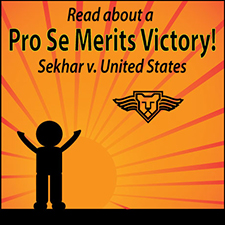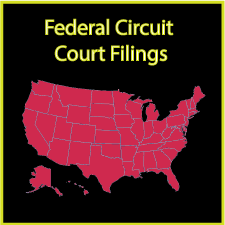Petition of the Month, Winter 2015: Baumgartner v. United States
The Supreme Court Press “Petition of the Month”TM for May 2015 is Baumgartner v. United States, Supreme Court Dkt. No. 14-1071, an appeal coming out of the Sixth Circuit Court of Appeals. The petition was filed by attorneys Donald Bosch and Ann Short of the Bosch Law Firm.
Question Presented:
1. Whether the First Amendment permits the government to criminalize private conversations with local officials and private citizens that have no connection to any federal crime or investigation and that have no ability to impede a federal investigation.
2. Whether the element of “concealment” in 18 U.S.C. § 4 permits the government to criminalize private conversations with local officials and private citizens that have no connection to any federal crime or investigation and that have no ability to impede a federal investigation.

In one of the most memorable television episodes in history, the Seinfeld gang - Jerry, Elaine, George, and Kramer - are seen in a jail cell, with the camera slowly fading away, for the crime of misprision: the failure to report a crime, or to act in order to conceal a crime. (to be techically accurate, the Seinfeld gang was arrested for "duty to rescue" for failure to help a carjacking victim) In the case of Baumgartner v. United States, Supreme Court, Dkt. No. 14-1071, Richard Baumgartner was convicted of the federal misprision statute for allegedly concealing a crime from a private citizen, entirely unconnected to law enforcement or an investigation. Mr. Baumgartner challenges this conviction on First Amendment grounds and argues that his speech to a private person has no concealing affect, since it did not happen in the context of a criminal investigation. For nearly 19 years, Mr. Baumgartner was a Tennessee state judge. Tragically, he became addicted to prescription drugs supplied by one of his probationers, lost his position on the Tennesee bench, and was prosecuted successfully in the state of Tennessee. Federal prosecutors then took a second bite, charging him under federal law for misprision. Specifically, they allege that character references he made to help the probationer, with whom he had developed a personal relationship, were acts of conealment, despite the fact that they were not made to law enforcement. |

| Thank you for discussing the Richard Baumgartner case with us. To be honest with you, we did a double take when we first saw this case, because we are not used to seeing trials and convictions under the federal misprision statute. We usuallyseemisprision in plea bargains as a lesser included safety valve. | |
Congress enacted the very first series of federal offenses with the passage of the 1790 Crimes Act, which specified 23 federal crimes. When we dug into the history books, we learned that among those crimes was misprision of felony. We could fmd no legislative history indicating exactly what Congress intended when it passed the statute. When we looked across the pond to England, our research uncovered an interesting debate whether the offense actually had a historical foundation in English common law. Arguably, the offense never had a meaningful existence beyond textbook writers and historical scholars. The first case in this country we found that construed the statute was decided in 1934. The question was whether a person’s failure to report a federal crime is, itself, concealment. The answer that has been adopted by every federal circuit to consider the matter is that the statute requires an “affirmative act” of concealment in addition to a failure to report. |
|
Turning now to your client, Richard Baumgartner. He was formerly a Tennessee State Judge. What happened to him in the Tennessee courts? |
|
In 1992, Richard Baumgartner was appointed to serve as Knox County, Tennessee Criminal Court Judge. He was elected and re-elected to serve for nearly 19 years. He was a hardworking and highly respected jurist who presided over some of the most difficult homicide and death penalty cases ever prosecuted in Knox County. His downfall was tragically rooted in an addiction to prescription pain medication, stemming from multiple medical problems for which he sought treatment. Ultimately, Richard’s addiction led him to seek out and illegally obtain opiates from other individuals, including one person who was on probation out of his court. The Tennessee Bureau of Investigation launched an investigation that resulted in a plea in state court to official misconduct. Mr. Baumgartner was allowed to keep his state pension, but he resigned his judicial office. He publicly admitted his addiction, and he permanently surrendered his license to practice law. |
|
For whatever reason, that was not good enough for the Federal prosecutors. They went after him a second time. Why do you think they did that? |
|
I won’t presume to speak for the federal prosecutors; you would need to ask them personally. All I can tell you is what happened after the state plea. The plea generated considerable media attention. Public opinion was mixed, with a noticeable segment of the community expressing sympathy and appreciation for Richard’s years of service as one of Knoxville’s most popular and hard-working judges. Sympathy began to sour in late 2011 and the beginning of 2012, when the special judge who took over Mr. Baumgartner’s cases ordered new trials for four defendants involved in the torture and killing of a young Knoxville couple. The public backlash from having to retry the murder cases and from learning that Mr. Baumgartner kept his state pension was swift and harsh. Fourteen months after the state plea, Mr. Baumgartner was arrested and arraigned on federal charges. |
|
Let’s now discuss the federal charges. He was charged with 7 counts of misprision of a felony. What was the federal theory behind the charges? Can you elaborate on their theory of “concealment”? |
|
The indictment alleged that a woman, Deena Castleman, was part of a federal conspiracy to obtain and distribute opiates, such as hydrocodone and Oxycodone, and that Mr. Baumgartner had actual knowledge of that federal conspiracy. Indeed, Mr. Baumgartner purchased opiates from Ms. Castleman. For each of the seven counts, the specific “concealment” alleged was that Mr. Baumgartner made “material misrepresentations” either to local officials or to private citizens about Ms. Castleman. The indictment did not allege and the government did not claim that Mr. Baumgartner was a member of the conspiracy or that he was an accessory after the fact. The theory of prosecution rested solely on his statements to and conversations with a state court trial judge, hospital employees, a general sessions court judge, a juvenile court magistrate judge, the head of transitional housing at a local YWCA, and a local county prosecutor. |

Did they charge or convict him of 18 U.S.C. §1001? Were they able to connect the alleged false statements with the impedance of an investigation? |
|
The government did not charge and could not have convicted Mr. Baumgartner of a § 1001 violation because his conversations were with local officials and private citizens and because the conversations were not related to any matter within the jurisdiction of the executive, legislative, or judicial branch of federal government. The Sixth Circuit has been willing to affirm § 1001 convictions when false statements were made to private entities but only if the entity received federal funds or was subject to federal regulation or supervision. That situation did not exist here. In our case, Castleman, herself, was a drug addict whose addiction led to state criminal charges for narcotics possession (not distribution), burglary, and DUI and to contempt charges for failing to pay child support and to hospitalization for drug-related medical problems and to housing problems. Mr. Baumgartner’s conversations were about Castleman’s personal and legal problems. Her possible involvement in a federdl drug distribution conspiracy was never mentioned. Absolutely no evidence was introduced at trial that Castleman or any of her coconspirators were being investigated at the federal or even local level for opiate distribution. Ironically, neither Castleman nor any of her opiate sources were ever prosecuted for their distribution activities. |
|
What are the First Amendment implications of criminalizing a person’s conversations with a private party? |
|
The implications are huge because few threats to our constitutional way of life are as dangerous as suppressing speech by making it a federal crime. Keep in mind, we are talking about criminalizing conversations that have nothing, even remotely, to do with someone else’s involvement in a federal crime—conversations that cannot possibly hinder federal law enforcement efforts or impugn the integrity of government processes. As we view it, the question is not whether criminalizing these conversations creates a slippery slope but, instead, just how steep is this slope. |
|
How do youseethis case squaring with the Supreme Court’s decision in United States v. Alvarez, 132 S. Ct. 2537? |
|
Alvarez—the “Stolen Valor” case—was decided about a month after the indictment was returned against Mr. Baumgartner. Alvarez debunked the government’s long-held position that all false statements of fact fall outside the First Amendment’s scope. The government had pointed to federal statutes, such as § 1001, false statements to a governmental official, and § 1623, perjury, as supporting its argument that false statements are not protected by the First Amendment. The Supreme Court responded that those statutes don’t merely restrict false speech; they are designed to uphold the integrity of the federal trial system and protect the integrity of government processes. The statement in Alvarez that really caught our attention concerned § 1001. The Supreme Court cautioned that § 1001’s prohibition did not lead to the broader proposition that false statements are unprotected when made to any person, at any time, in any context. That warning, we contend, foreshadowed what happened in Mr. Baumgartner’s case. |
|
You conducted a comprehensive review of over 100 misprision cases and presented them to the Court in your petition. What did you learn from your study? |
|
The number is actually closer to 600 misprision cases that we reviewed. From that review, we confirmed our initial belief that misprision is frequently used as a landing point for compromises in reaching plea agreements. We were surprised to discover that the largest category consists of civil cases with plaintiffs trying unsuccessfully to allege misprision as a cause of action. What we found particularly significant for our purposes was that prosecutions based on “verbal” acts of concealment had a common theme. With the exception of three or four instances, the misrepresentations were made to federal authority figures, which, of course, did not occur in Mr. Baumgartner’s case. |
|
Has the Supreme Court decided many cases related to misprision? Do you believe this is a case of first impression? |
|
The Supreme Court has mentioned misprision of felony, somewhat in passing, in three decisions. It has commented that misprision of felony has long been against public policy, and it has noted a common law duty to raise the “hue and cry” and report felonies to the authorities. Whether the government can use misprision to criminalize conversations that have nothing, even remotely, to do with someone else’s involvement in a federal crime is an important question of first impression. |
|
What do you think are bigger picture implications of the conviction if it is allowed to stand? |
|
This conviction is a classic example of a matter swiftly and effectively addressed at the local level, and yet a federal prosecution was vigorously pursued months later. If allowed to stand, every citizen legitimately should fear that his or her conversations could, at any time, be swept into the net of federal wrongdoing. It is no overstatement that this conviction basically hands a loaded gun to every prosecutor struggling to find some basis to charge a citizen with a federal crime. |
|
In closing, is there anything you'd like to add about the case or your experience working with the Supreme Court Press. |
|
We were impressed and totally satisfied with the experience working with the Supreme Court Press and, in particular, with the Editor, Geary. It was liberating not to worry about the dozens of intricate formatting and procedural rules that must be followed before the Supreme Court will accept a filing. We could focus on developing persuasive arguments and explaining why a writ of certiorari should be granted. Geary brainstormed our arguments with us. He made many helpful suggestions on what facts to emphasize and what legal points may appeal to certain members of the Court. We pride ourselves on the quality of our writing: grammatical correctness; spelling; citation form, etc. The draft markup we received thankfully caught a few errors that we missed. Comments within the draft markup were relevant, and although we did not adopt all the suggestions, many of them convinced us to change certain language and emphasis. We worked with Geary during the horrid weather in February 2015 that paralyzed the North East and South East parts of the country. Geary was always available by phone and email. We never worried that the weather would interfere with the timely filing of our petition by the Supreme Court Press. For our future needs, we definitely will contact Supreme Court Press. |
 We were impressed and totally satisfied with the experience working with the Supreme Court Press . . . It was liberating not to worry about the dozens of intricate formatting and procedural rules that must be followed before the Supreme Court will accept a filing. We could focus on developing persuasive arguments and explaining why a writ of certiorari should be granted . . . The draft markup we received thankfully caught a few errors that we missed. Comments within the draft markup were relevant, and although we did not adopt all the suggestions, many of them convinced us to change certain language and emphasis. - Ann Short
We were impressed and totally satisfied with the experience working with the Supreme Court Press . . . It was liberating not to worry about the dozens of intricate formatting and procedural rules that must be followed before the Supreme Court will accept a filing. We could focus on developing persuasive arguments and explaining why a writ of certiorari should be granted . . . The draft markup we received thankfully caught a few errors that we missed. Comments within the draft markup were relevant, and although we did not adopt all the suggestions, many of them convinced us to change certain language and emphasis. - Ann Short

---Bryan-Krumm.png)
---ZoeSpencer.png)


